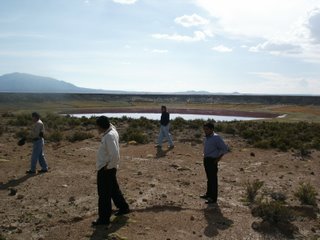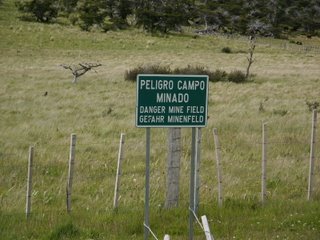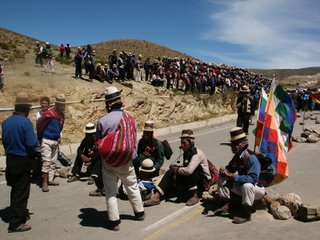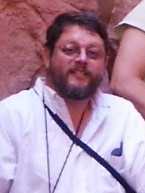
Dark and stinkin’ early Thursday (the 30th of March) morning, Percy (the local engineer whom I am grooming to take my place when I leave Bolivia) picked me up from my house in the company Land Cruiser. Even though we were only planning to be gone for two days and one night, we loaded enough gear into the back of the vehicle to camp for a week – our sleeping bags, camp cots, suitcases, laptops, and my field bag complete with binoculars, Leatherman (the original – accept no substitutes), GPS, digital camera, toilet paper, compass, flashlight, rain poncho, sunscreen, insect repellant, baseball cap, and most importantly, Dramamine. On our way out of town we needed to fill the tank – I had to direct Percy to the nearest gas station since we were down in my neighborhood. After scooting down what passes for a major highway in Bolivia (a narrow two lane road) for three hours and 240km we arrived in Oruro right on schedule. There we were supposed to hook up with the electrical department employees of the Prefecturas of both Potosi and Oruro, to visit a rural electrification project that starts in Oruro and ends in Potosi. Unfortunately for us, the hometown boys were in meetings rather than getting ready to go so we had to cool our heels for a couple of hours. But that gave us time to stock up on provisions – so we drove over to the market and loaded up on groceries – a loaf of wheat bread, a can of sausages, and a can of corned beef – and a flashlight and baseball cap for Percy. Finally the Oruro boys showed up and we headed out of town.
At the end of the pavement we stopped for lunch – it was that late in the day already – in a little lunch dive that one of the guys knew. While we ate we saw on the noon news that the pilots and workers of the Bolivian airline were not only still on strike, but they’d taken over the runways of the three major airports of Bolivia – La Paz, Cochabamba, and Santa Cruz – shutting down all air traffic in and out of the country. Before dessert Evo sent in the army to clear the runways and restore air traffic in Bolivia. At one point on the live news broadcast, the head of the protestors looked straight into the camera and told Evo that “You taught us to blockade and so here we are.” After lunch we hit the road and drove for another 300km, over hill and dale, through amber (and purple, red, orange, and green) waves of quinoa, herds of llamas, alpacas, and vicuñas, and past the lost city of Atlantis (see http://www.geocities.com/webatlantis/.) The road we took was well traveled even though it was a bumpy dusty dirt road – according to my Bolivian companions it’s the major ingress for all of the stolen cars that are brought in from Chile. At kilometer 468 from La Paz, we came across a huge meteor crater – now filled with a lake in the bottom and the sides of the bowl all cultivated in quinoa. Eventually we got to the end of the line, where our project was to start. One of our traveling companions, who is a bureaucrat from the new MAS government of Oruro, a real party man, was from the area and wanted to convince us to re-route our power lines through his home village of Jirira. It is a “very important” tourist center, he told us. We actually got there very late – at around 8PM – well after dark, but from the state of the roads I could tell that there weren’t too many tourists that have ever passed through there (even our homeboy guide got lost in the dark once.) We checked into our guide’s family’s hotel and were shown to our rooms – small rustic cells with two beds and a toilet (no shower) – they sure beat sleeping outside. At 9:00 we were invited to dinner of broth and a piece of bread – the aunt/owner of the hotel said that she would have killed us a llama if she’d known when we were coming. At 10:00 we were told that our guide had convoked a town meeting, in which he hoped the town’s people would convince us that we should re-route our line through their community. I told him I wasn’t very interested in going to a community meeting right at bedtime, just when I’m at my crankiest – “it’ll only last a half hour” he lied. We stumbled in the pitch dark to the small community center – with the nearest electric lights a world away, the star show was awesome. Inside the black cave of the community center, lit by only one candle, I could just make out approximately 25 non-descript shadows lining the walls of the small room. The only people I could really see were Percy, sitting next to me, and a couple of ladies sitting on the other side of the candle, dipping into bags of dried coca leaves, and the two representatives from the two prefecturas sitting at the head table. As they spoke, one of the ladies generously shared a pile of coca leaves with our two dignitaries. The bureaucrat who had brought us to this town repeatedly stated that now that “we’re in power” things would start to get accomplished, not like when all of the corrupt politicians were in power and plundering everything. After about an hour of assuring the people that we didn’t have the necessary funding to divert our power lines through their community, Percy, bless his heart, excused ourselves and we headed back through the dark to our hotel. We both had tiny pocket flashlights and managed not to fall into any wells, but we had a dickens of a time finding the hotel again since our guide had stayed behind to chat with his family and neighbors. The bed was a bit like sleeping in a hammock, but by then I was so tired and beat from the long journey I think I could have slept on the floor.
The next morning, after a cold spit bath, we enjoyed a breakfast of a piece of fried bread (just like the Navajos fix) and a cup of coffee or tea. I mentioned that I didn’t drink either coffee or tea, so they offered me an herb tea. Aunt so-and-so brought me out a little sprig of leaves and twigs which actually smelled really good – I couldn’t tell you what they were or even describe what they smelled like – and so I steeped them in my cup of hot water, which I drank with a healthy dressing of sugar. After “breakfast” our guides from the prefectura abandoned us – they finally caught on that they were wasting their time – and so Percy and I went on our way to survey the rest of towns in the area to see if they warranted a future line extension. By the light of day the place was still very rocky and dusty, but we were right alongside the edge of the “Salar” – one of Bolivia’s prime tourist destinations. The Salar in Bolivia is this huge salt flat, 100km wide by 140km long, and we were sandwiched between the Salar and this huge extinct volcano. We circumnavigated the volcano, checking out the three little towns between where we had camped out and where our current project ends – we found that the towns were mostly ghost towns, with more ruins than inhabited houses – I think we’d have a hard time justifying a new electrification project in that area. So we turned our sites toward home – stopping only to eat our loaf of bread and can of sausages and corned beef. Once, about halfway home, we were overflown by a migrating flock of neon pink flamingos headed north for the winter – now that was truly a site to behold.
I dropped Percy off at the bus station in Oruro so he could take the bus home to Cochabamba, and then drove the last three hours home alone. Fortunately, foreseeing just such an eventuality, I had brought along some suitable CDs to drive to – Ray Charles and Hit the Road Jack and the Cars and Let the Good Times Roll. I hadn’t broken out my music earlier in the trip, because my American music makes the Bolivians crazy and theirs drives me insane, so it’s better not to have any music. Anyway, late that night, after a trip of over 1000km, I made it back to La Paz safe and sound. No road blocks, no flat tires, and no running out of gas – overall it was a good trip. Whew. Next stop: The Galapagos.






